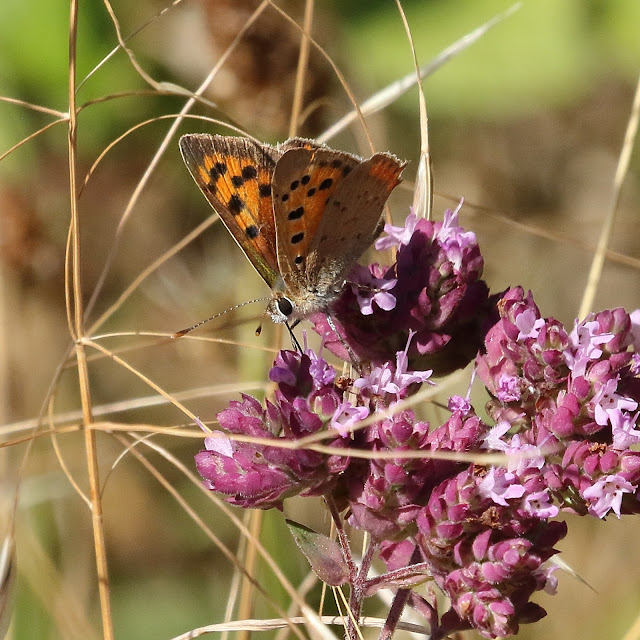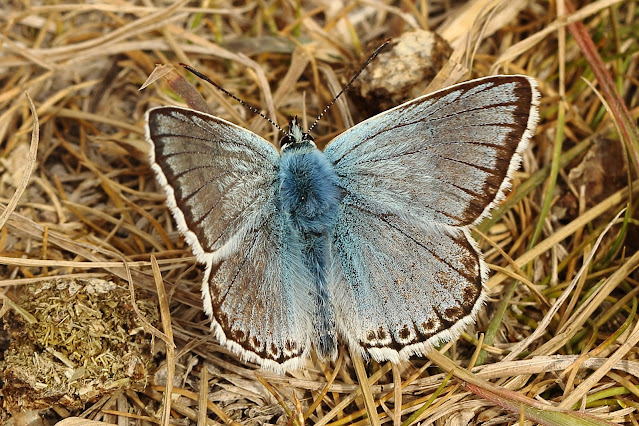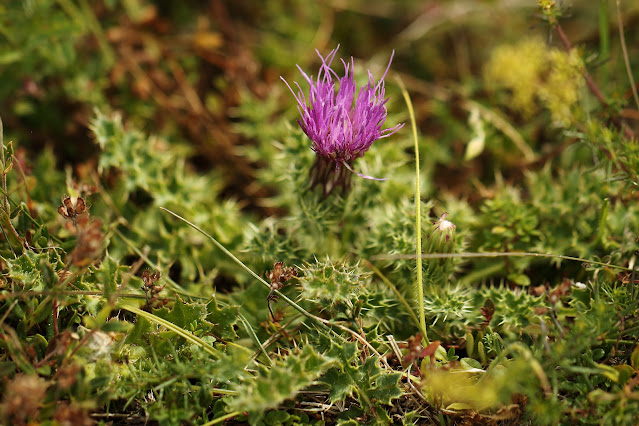Sightings and news for the Naturewatch group of Great and Little Abington in Cambridgeshire, UK. See below for more details and information on how to join.
Sunday 21 August 2022
ANW trip - walk around Granta Park
Impressive Moth Caterpillars
17th August 2022 - Emma J discovered a couple of different moth caterpillars in her garden recently. The impressively large Elephant Hawkmoth caterpillar was making short work of some fuchsia plants, whilst an equally striking Knot-grass moth caterpillar preferred to feed on her oregano plants.
Juvenile Robin
4th August 2022 - a juvenile Robin took the opportunity of an open door to take a look around the inside of Polly M's house recently. It hadn't quite sussed out what window glass was all about yet though, and had to be gently 'assisted' back towards the open door.
Common Toad - braving the heat!
16th August 2022 - Emma J was a little surprised to find a small Common Toad in her very hot and bone-dry glasshouse recently, but it seemed happy enough living amongst the damp soil of the watered plants.
Emperor Dragonfly - close-up!
10th August 2022 - during the recent hot weather there have been a number of dragonflies buzzing rapidly around Andy M's garden. Whilst one can sometimes get a good enough view to identify the species, it can be very hard to really see the detail when they are moving so fast.
However, whilst rather sad for the individual, when we discovered a male Emperor Dragonfly that had become trapped and 'baked' in our greenhouse, it did present an opportunity to take some closeup photos of this amazing creature. In particular, the details of the eyes, mouthparts and wings are fascinating.
Wednesday 10 August 2022
Common Darter dragonfly
8th August 2022 - this Common Darter dragonfly put in an appearance in Polly and Andy's garden this week, and conveniently took a short break from rushing about to allow its photo to be taken.
Butterflies amongst the flowers
7th August 2022 - a walk along the Old Railway Cutting was a rather dry, dusty experience this week, but there were patches of bright colour, with the Wild Marjoram, Wild Basil and Common Knapweed coming nicely into flower. These were proving to be something of an oasis for a number of butterflies, including many Gatekeeper, Common Blue, and the second brood of Holly Blue and Small Heath. Unusually, Small Copper and Brown Argus also put in an appearance - Andy M.
Young House Mouse
4th August 2022 - Derek T saw this rather quiet young House Mouse in his garden - no doubt it was feeling slightly the worst for wear during this the hot weather.
What splendid antennae you have!
4th August 2022 - Joan N spotted this rather beautiful large moth resting on her window, and took this photo to shown off its rather splendid antennae. The exact species is not certain, but it may be a type of hawkmoth.
Say 'Ribbit!'
1st August 2022 - Andy M spotted up to five Common Frog in his small garden pond - no doubt a tiny oasis for them during this hot, dry weather - and some of them even hung around long enough to have their photo taken!
July 2022 - Interesting Sightings from around the Abingtons
July 2022
Amphibians and Reptiles
Common Toad - spotted in and around two ponds in LA
and one in GA, and a Grass Snake was seen in a LA garden. Please keep an
eye out and send in any sightings as there may be more of these species seeking
any water available in this dry weather.
Birds
A total of 48 species were
seen or heard this month in a total of 261 records, as we entered a generally
quieter period for garden birds, especially with many birds sheltering quietly during
the heat of the day. However, good numbers of young birds continued to be seen,
including Blue Tit and Great Tit, Swallow, Jay, Buzzard, and both Great Spotted
and Green Woodpecker.
A Kingfisher was
again seen occasionally, feeding along the river through Sluice Wood, and the
female Mandarin Duck, with three grown ducklings, also still around along
the river in GP.
A male Tufted Duck was
spotted on the GP lake on 8th, as was a Cormorant (31st), as well as 3-5
Barnacle Goose, good numbers of Mallard and a Moorhen with
one chick.
A pair of Bullfinch
was spotted feeding alongside the river on GP and, unusually for GP, a Nuthatch
was heard and seen in the woods along the south side of GP. Also unusually, a Treecreeper was
spotted in a Cambridge Rd garden on 31st.
The good numbers of Swallow
(around 50) reported on LSA were mostly juveniles indicating a good first brood
this year (10th, blog
link). Some pairs will now mate again and continue with a second brood.
Swift were regularly reported especially early on, and up to 20 were seen
wheeling above LA church on 21st, possibly a final gathering before heading
south. The last sighting this month was of only 2 birds on 25th. Small numbers
of House Martin (2-3) were spotted around the shop, in Mortlock Gardens
and around Bourn Bridge Rd.
Small groups of Blue
Tit and Great Tit were regularly reported visiting feeders, with a
group of around 20 seen on 27th. Good numbers of young Blue Tit (blog
link) seen in Sluice Wood too. A single Coal Tit was regularly seen
in a Cambridge Rd garden, as well as two Long-tailed Tit reports.
A few young Goldfinch
and Greenfinch were also regularly reported on feeders, as well as along
the ORC, with 1-2 Chaffinch also seen in Cambridge Rd. A few Robin,
Wren and Dunnock were also regularly seen, with young spotted
after 17th. Pied Wagtail were also reported, including an adult with
young on the LSA (22nd), and around 12 on GP (31st). Up to 4 Blackbird, and a single Song
Thrush were also seen.
Both Common
Whitethroat and Lesser Whitethroat were reported along the ORC on
3rd, the former also heard singing. A Chiffchaff was reported once
(3rd), and 1-2 Blackcap were seen at several locations, including a pair
spotted for the first time in a garden on North Rd, LSA.
A single Buzzard
was reported above several sites, including a likely juvenile perching along Church
Lane, and heard mewing above GP. A Red Kite was spotted six times around
the village, and a Sparrowhawk was seen taking a pigeon on Meadow Walk. A
Kestrel was spotted at a number of locations, including the woods along
Pampisford Rd, and one was seen apparently feeding on flying ants (8th).
Green Woodpecker
were seen at several locations, with three around the Perse sports fields (blog
link) and GP, a female and a juvenile in a Cambridge Rd garden, and one regularly
visit a garden in Meadow Walk. One or two Great Spotted Woodpecker, including
a juvenile continued to be seen in a Cambridge Rd garden, and an adult was seen
feeding on ants in Lewis Cres.
Collared Dove and
Stock Dove regularly seen around Lewis Cres, as were a few House Sparrow,
including young birds. An adult and two young Jay were seen feeding on apples
(21st), a small flock of Starling were spotted on the LSA, and a Skylark
was occasionally heard singing early in the month.
Butterflies and other insects
This month, several
butterfly and dragonfly species were reported for first time this year, as the total
number of reports increased yet again to the highest this year! Amazingly, a
total of nineteen butterfly species were reported this month. Overall, during July,
a total of 187 records were received: butterflies 169, odonata 4, bees 5, others
9.
Butterflies: Three
butterfly species were first reported this year during July: Gatekeeper
(regularly throughout the month from 3rd, 16 reports, blog
link), Silver-washed Fritillary (13th, 1 report, blog
link) and Purple Hairstreak (18th, 1 report, blog
link), the latter two being unusual for the Abingtons.
Numbers of reports of Brimstone,
Small White, Large White and Gatekeeper were particularly high,
as were Comma, Small Tortoiseshell and Meadow Brown. Interestingly,
second brood Peacock numbers were up again in July, following no reports
in June. Gatekeeper and Ringlet were seen in particularly good
numbers along the ORC, as were Meadow Brown, Peacock and Small
Skipper.
Reports of Brimstone, Peacock,
the ‘Whites’ and Common Blue (blog
link) were all up relative to June, but the relative numbers of Small
Tortoiseshell, Large Skipper, Meadow Brown, Painted Lady and
Marbled White all dropped this month. Other species continued to be
reported in similar numbers to June.
Numbers of Butterfly reports: Brimstone
21, Small White 17, Gatekeeper 16, Large White 15, Meadow Brown 14, Comma 14, Small
Tortoiseshell 12, Peacock 10, Ringlet 10, Red Admiral 9, Green-veined White 8,
Common Blue 5, Marbled White 5. Others: Holly Blue, Small Skipper, Speckled
Wood, Large Skipper, Silver-washed Fritillary, Purple Hairstreak all 1-3 reports.
Odonata: Emperor Dragonfly continued to be
reported (17th, 1 report, blog
link), with Southern Hawker (from 4th, 2 reports) and Common
Darter (8th, 1 report, blog
link) being seen for the first time during July.
Other: Hummingbird Hawkmoth (4 reports, blog
link), Red-tailed, White-tailed and Buff-tailed Bumblebee
(5 reports in total), as well as reports of a Red-legged Shieldbug, Burnet
Moth, Small Emerald Moth (blog
link), Hornet and a dor beetle species.
Mammals
Bat – probably Pipistrelle,
seen regularly around gardens along Cambridge Rd and Lewis Cres
Common Shrew – dead
one found in a Cambridge Rd garden on 10th.
Hedgehog – one
in a Lewis Cres garden on 6th and again on 18th and 24th. Two also seen in another
Lewis Cres garden on 18th, a mother and two hoglets seen on 24th, and two more
adults later on the same night.
Muntjac – one in
a Lewis Cres garden on 6th, one in the field behind Cambridge Rd on 17th, and
one dead on the Carriage Track also on 17th.
Flora
The continuing dry weather and high temperatures have meant many annual and perennial flowers have finished early. Very few reports of wildflower species in bloom this month: Welted Thistle, Chicory.
RiverCare
A second river sampling session was held on 26th July, which went ahead in spite of very little rain and low flows. It was noticeable that there was no weed at the site and our results were also very sparse, with very low numbers of Mayfly, which is the main interest for the Riverfly recording process we follow. Very few Shrimp, which are often found in very large numbers. We did catch a fish (Bullhead or Miller’s Thumb) and the usual Signal Crayfish, as well as a number of surface insects (Pond Skater and Water Boatman) when sweeping the marginal vegetation. No species was numerous this time.
Weather
Dry! Dry! Dry! With a total of 9.25 mm rain for
the month. The highest temperature was on 19th when it hit 42.3 degrees C and
the lowest was 7.3 degrees C on 5th July. The beginning and end of the month
were relatively still, with a breezy spell in the middle but it was a hot wind.
NatureWatch Trips
There were three interesting ANW trips
this month; to Lackford Lakes (blog
link), Wicken Fen (blog
link) and Fleam Dyke (blog
link). See the blog links for full reports.
Sunday 7 August 2022
Visit to Fleam Dyke - Chalk Hill Blue butterflies everywhere!
30th July 2022 - four ANW members had a great trip along Fleam Dyke, witnessing literally thousands of Chalk Hill Blue butterflies. At virtually every step there was a Chalk Hill Blue on the path, and looking either side one could easily see ten or twelve within a few feet. Along the kilometre or so of the dyke we walked, there really must have been thousands. Male Chalk Hill Blue butterflies are pale blue on the upper with a contrasting black and white border, whereas the females are mostly brown with orange spots on the lower wing, also with a white border. Undersides are very similar to the Common Blue, but lack the bright orange spots on the upper wing, with males tending to be paler than females.
There were also one or two of several other butterfly species, and also a few interesting chalkland plants such as Horseshoe Vetch and Clustered Bellflower.
The Aims of Abington Naturewatch
At their meeting on 9 April 2005 the members approved this revised version of the aims of Abington Naturewatch:
- To monitor and record the wildlife (fauna & flora) within the borders of the Abingtons;
- To encourage protection of our wildlife, maintain its quality and foster its diversity;
- To promote awareness of the richness, potential and problems of the natural environment of the Abingtons;
- To cooperate in improving access to the local natural environment for the benefit of all Abington villagers.
The organisation is informal and communication is by email if possible; members are notified of events from time to time. Contact details are maintained by a small "project team". There is currently no membership fee as costs are covered by voluntary contributions at events.
Members are encouraged to report notable sightings of flora and fauna within the Abingtons to the appropriate sector coordinator and an illustrated record is published annually.
A map of the area covered, with some features noted, is available here: http://maps.google.co.uk/maps/ms?ie=UTF8&hl=en&msa=0&msid=213774935674882866424.00000111dca2be9f06ab8&z=13>
For more information or to join, please contact David Farrant on (01223) 892871.
Contributions to our records should be sent to sector contacts or either of the above. Photographs may also be submitted to Andy Merryweather (amerryweather61@gmail.com)








































































